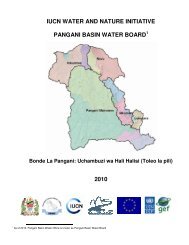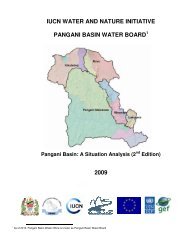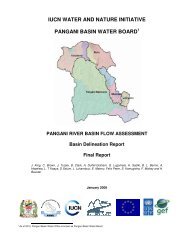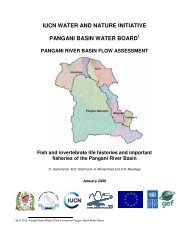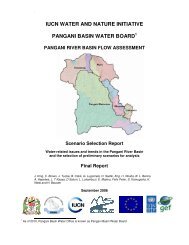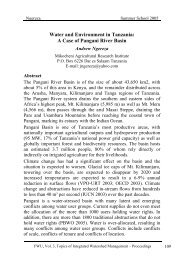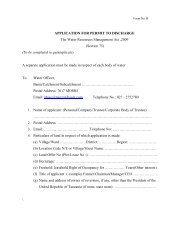Managing Conflicts Over Land and Water Resources in Pangani River
Managing Conflicts Over Land and Water Resources in Pangani River
Managing Conflicts Over Land and Water Resources in Pangani River
You also want an ePaper? Increase the reach of your titles
YUMPU automatically turns print PDFs into web optimized ePapers that Google loves.
Eastern <strong>and</strong> Central Africa Programme for Agricultural Policy Analysis<br />
ECAPAPA<br />
MANAGING CONFLICTS OVER LAND AND WATER<br />
RESOURCES IN PANGANI RIVER BASIN: A STUDY OF<br />
CONFLICT MANAGEMENT IN PLURAL LEGAL SETTINGS<br />
By<br />
Ibrahim Juma, PhD<br />
Sikitiko Kapile, M.A.<br />
Omari Wahure, M.A.<br />
PEMconsult East Africa Ltd.<br />
People Environment Management
<strong>Manag<strong>in</strong>g</strong> <strong>Conflicts</strong> <strong>Over</strong> <strong>L<strong>and</strong></strong> <strong>and</strong> <strong>Water</strong> <strong>Resources</strong> <strong>in</strong> <strong>Pangani</strong> <strong>River</strong> Bas<strong>in</strong><br />
Table of Contents<br />
Table of Contents 1<br />
1. Background 2<br />
2. General <strong>and</strong> Specific Objectives of the Study 2<br />
3. Methodology 2<br />
4. Outputs/Intended Policy Use 2<br />
4.1 Undertaken Activities 3<br />
4.1.1 Archival <strong>and</strong> Library research 3<br />
4.1.2 Key Informant Interviews 3<br />
4.1.3 Documentary Review of Village Records, By-laws <strong>and</strong> Court Cases 4<br />
5. Achievements 4<br />
5.1 Nature of conflicts 4<br />
5.1.1 Ma<strong>in</strong>stream<strong>in</strong>g Traditional Practices Through <strong>Water</strong> Users’ Associations 4<br />
5.1.2 <strong>Conflicts</strong> between Upstream <strong>and</strong> Downstream Users 5<br />
5.1.3 An Example of Surviv<strong>in</strong>g Traditional System Based on the Clan System 6<br />
5.1.4 Village Governance Structure Eroded Traditional Systems 6<br />
5.1.5 Problems fac<strong>in</strong>g <strong>Pangani</strong> Bas<strong>in</strong> <strong>Water</strong> Office 6<br />
5.1.6 <strong>Conflicts</strong> Aris<strong>in</strong>g out of Old Estates 7<br />
5.1.7 Examples of <strong>in</strong>teractions between traditional <strong>and</strong> modern water management<br />
systems 8<br />
5.2 Guidel<strong>in</strong>es on Implement<strong>in</strong>g Integrated <strong>Water</strong> <strong>Resources</strong> Management 9<br />
5.3 Increased Awareness of <strong>River</strong> Bas<strong>in</strong> Managers <strong>and</strong> Policy Makers 9<br />
Appendix 2: Field Research Tasks for Research Assistants 11<br />
Appendix 3: Terms Of Reference 13<br />
Draft F<strong>in</strong>al Report for ECAPAPA<br />
1
<strong>Manag<strong>in</strong>g</strong> <strong>Conflicts</strong> <strong>Over</strong> <strong>L<strong>and</strong></strong> <strong>and</strong> <strong>Water</strong> <strong>Resources</strong> <strong>in</strong> <strong>Pangani</strong> <strong>River</strong> Bas<strong>in</strong><br />
1. Background<br />
The study to facilitate the formulation of better policies <strong>and</strong> guidel<strong>in</strong>es for manag<strong>in</strong>g resource<br />
use conflicts <strong>in</strong> plural legal systems, was prompted by current l<strong>and</strong> <strong>and</strong> water reforms that are<br />
underway <strong>in</strong> most African countries. These reforms focus on the use of statutory legal systems<br />
to regulate the use of l<strong>and</strong> <strong>and</strong> water resources. However, all of these countries have a<br />
pluralistic legal system - l<strong>and</strong> <strong>and</strong> water resources are regulated by different pieces of<br />
legislation <strong>and</strong> <strong>in</strong>stitutions, <strong>in</strong>clud<strong>in</strong>g statutory law, customary laws of the different ethnic<br />
groups <strong>and</strong> Islamic law. The diverse customary norms <strong>and</strong> laws are often more important than<br />
statutory law <strong>and</strong> are relied upon <strong>in</strong> resolv<strong>in</strong>g natural resource management conflicts. In these<br />
countries, statutory laws regulate very few human activities. Neglect of customary laws may<br />
have negative consequences for <strong>in</strong>dividuals <strong>and</strong> groups who were better served by customarybased<br />
systems.<br />
2. General <strong>and</strong> Specific Objectives of the Study<br />
Given the above background, the study was set to <strong>in</strong>vestigate how conflicts over l<strong>and</strong> <strong>and</strong><br />
water resources are managed <strong>in</strong> <strong>Pangani</strong> river bas<strong>in</strong>. The general objective of the research<br />
project was to describe <strong>and</strong> analyse customary <strong>and</strong> statutory systems of utilis<strong>in</strong>g <strong>and</strong> manag<strong>in</strong>g<br />
l<strong>and</strong> <strong>and</strong> water <strong>in</strong> the study area. The research had three specific objectives:<br />
• to analyse the extent to which there are differences <strong>in</strong> the management of l<strong>and</strong> <strong>and</strong> water<br />
resources between farmers with customary <strong>and</strong> those with statutory tenure rights;<br />
• to analyse how differences <strong>in</strong> tenure affects the resolution of conflicts over access to <strong>and</strong><br />
use of l<strong>and</strong> <strong>and</strong> water resources; <strong>and</strong><br />
• to identify legal <strong>and</strong> socio-economic factors that facilitate <strong>and</strong>/or constra<strong>in</strong> efforts towards<br />
sound management of l<strong>and</strong> <strong>and</strong> water <strong>in</strong> the study area.<br />
3. Methodology<br />
Us<strong>in</strong>g the <strong>Pangani</strong> river bas<strong>in</strong> as the study area, the team sought to achieve the def<strong>in</strong>ed<br />
objectives through the follow<strong>in</strong>g set of approaches:<br />
• .Literature review<br />
• Archival search<br />
• Fieldwork<br />
• Feed-back workshops<br />
4. Outputs/Intended Policy Use<br />
On completion of this study, the follow<strong>in</strong>g outputs were expected:<br />
• A documentation of local l<strong>and</strong> <strong>and</strong> water conflicts, <strong>and</strong> the complementarities/tensions<br />
between statutory <strong>and</strong> customary systems of address<strong>in</strong>g conflicts.<br />
• Guidel<strong>in</strong>es on implement<strong>in</strong>g Integrated <strong>Water</strong> <strong>Resources</strong> Management under plural<br />
legal systems.<br />
Draft F<strong>in</strong>al Report for ECAPAPA<br />
2
<strong>Manag<strong>in</strong>g</strong> <strong>Conflicts</strong> <strong>Over</strong> <strong>L<strong>and</strong></strong> <strong>and</strong> <strong>Water</strong> <strong>Resources</strong> <strong>in</strong> <strong>Pangani</strong> <strong>River</strong> Bas<strong>in</strong><br />
• Increased awareness of river bas<strong>in</strong> managers <strong>and</strong> policy makers on the implications of<br />
plural legal systems for local conflict management, <strong>and</strong> empowered communities<br />
whose voices <strong>and</strong> own customary arrangements are better understood<br />
4.1 Undertaken Activities<br />
4.1.1 Archival <strong>and</strong> Library research<br />
The research team reviewed both grey <strong>and</strong> published literature on the implications of<br />
customary laws for l<strong>and</strong> <strong>and</strong> water management. In short, this review revealed the follow<strong>in</strong>g<br />
three key issues:<br />
• the potential role of customary norms <strong>in</strong> manag<strong>in</strong>g conflicts related to l<strong>and</strong> <strong>and</strong> water<br />
resources: this is prompted by the concern that <strong>in</strong>sufficient consideration to customary<br />
laws be<strong>in</strong>g given by new management regimes;<br />
• the potential of the new paradigm to impact negatively upon vulnerable groups which<br />
rely on customary-based systems to regulate their use of water resources <strong>and</strong> to manage<br />
water-related conflicts, <strong>and</strong><br />
• the potential of the efficacy of locally def<strong>in</strong>ed customary rights <strong>and</strong> local mechanisms<br />
for adjudication <strong>and</strong> water adm<strong>in</strong>istration.<br />
The research team also reviewed relevant literature on rural poverty, legal pluralism, gender<br />
<strong>and</strong> equity <strong>in</strong> water development, <strong>and</strong> customary laws. Also, the literature review sought to<br />
establish how conflict management is h<strong>and</strong>led <strong>in</strong> the FAO Legislative Study on Customary<br />
Law <strong>in</strong> Africa 1 . F<strong>in</strong>d<strong>in</strong>gs from similar studies 2 <strong>in</strong>dicate that there are enormous challenges<br />
fac<strong>in</strong>g the <strong>Pangani</strong> <strong>River</strong> Bas<strong>in</strong> Office <strong>in</strong> supervis<strong>in</strong>g l<strong>and</strong> <strong>and</strong> water management <strong>in</strong> the study<br />
area. These <strong>in</strong>clude the expansiveness of the <strong>River</strong> Bas<strong>in</strong>, <strong>and</strong> the limited number of officials to<br />
implement the ma<strong>in</strong>stream laws. The fact that water laws do not give exhaustive coverage over<br />
all areas <strong>in</strong> Tanzania, <strong>and</strong> the complex <strong>and</strong> diverse <strong>in</strong>ter-play between customary <strong>and</strong> statutory<br />
systems are issues which were pursued further <strong>in</strong> this research project. The team undertook a<br />
detailed review of literature <strong>in</strong> order to identify knowledge gaps to be complemented by<br />
fieldwork. Prior to literature review archival research was conducted concurrently to archival<br />
research at the National Archives (Dar es Salaam). Important unpublished studies <strong>and</strong> official<br />
documents were also analysed (see Appendix 1).<br />
4.1.2 Key Informant Interviews<br />
Us<strong>in</strong>g key guid<strong>in</strong>g questions (see Appendix 2), key <strong>in</strong>formant <strong>in</strong>terviews were conducted with<br />
different stakeholders with<strong>in</strong> the study area. The <strong>in</strong>terviewees <strong>in</strong>cluded officials from<br />
Kilimanjaro Regional <strong>Water</strong> Office (Hydrology Section) that is responsible with keep<strong>in</strong>g data<br />
on amounts of water <strong>in</strong> water sources; <strong>Pangani</strong> Bas<strong>in</strong> <strong>Water</strong> Office, <strong>in</strong> Moshi - responsible for<br />
management of water resources; an NGO named PAMOJA, concerned with the management<br />
of water conflicts <strong>in</strong> <strong>Pangani</strong> Bas<strong>in</strong>;, <strong>and</strong> the Zonal Irrigation Office. In addition to<br />
1 Ramazzotti, Marco, 1996. Read<strong>in</strong>gs <strong>in</strong> African Customary <strong>Water</strong> Law. FAO Legislative Study<br />
58. Development Law Service, Legal Office, Rome<br />
2 Maganga, F., et al , 2003. Implications of Customary Norms <strong>and</strong> Laws for Implement<strong>in</strong>g<br />
IWRM: F<strong>in</strong>d<strong>in</strong>gs from <strong>Pangani</strong> <strong>and</strong> Rufiji Bas<strong>in</strong>s, Tanzania. Paper Presented <strong>and</strong> the<br />
WARSFA/<strong>Water</strong>net Symposium, Gaborone, October 2003.<br />
3<br />
Draft F<strong>in</strong>al Report for ECAPAPA
<strong>Manag<strong>in</strong>g</strong> <strong>Conflicts</strong> <strong>Over</strong> <strong>L<strong>and</strong></strong> <strong>and</strong> <strong>Water</strong> <strong>Resources</strong> <strong>in</strong> <strong>Pangani</strong> <strong>River</strong> Bas<strong>in</strong><br />
<strong>in</strong>terview<strong>in</strong>g the above-mentioned key <strong>in</strong>formers, the researchers conducted very brief <strong>and</strong><br />
short <strong>in</strong>terviews with villagers <strong>and</strong> water users also to get the other side of the story about how<br />
government officials <strong>and</strong> NGOs’ view <strong>and</strong> underst<strong>and</strong> water use <strong>and</strong> management conflicts<br />
among villagers <strong>and</strong> other water users.<br />
4.1.3 Documentary Review of Village Records, By-laws <strong>and</strong> Court Cases<br />
The researchers also made an analysis of recorded cases <strong>and</strong> by laws utilised by the <strong>Pangani</strong><br />
Bas<strong>in</strong> <strong>Water</strong> Office, <strong>and</strong> Courts of Law <strong>in</strong> Moshi, Same <strong>and</strong> Mwanga <strong>in</strong> order to have an idea<br />
of the k<strong>in</strong>ds of cases filed, especially those related to l<strong>and</strong> <strong>and</strong> water resources <strong>and</strong> the different<br />
conflict resolution channels when decid<strong>in</strong>g on the cases applied. The researchers also wanted to<br />
explore what guidel<strong>in</strong>es are used.<br />
4.1.4 Dissem<strong>in</strong>ation <strong>and</strong> Feed-back Workshops<br />
The researchers held two workshops to dissem<strong>in</strong>ate their research f<strong>in</strong>d<strong>in</strong>gs <strong>and</strong> to get feed back<br />
from stakeholders. The first workshop was held <strong>in</strong> Moshi <strong>and</strong> <strong>in</strong>volved water bas<strong>in</strong> officials,<br />
water users, NGOs <strong>and</strong> water user associations. The second workshop was held <strong>in</strong> Same <strong>and</strong> it<br />
<strong>in</strong>volved NGOs, water users <strong>and</strong> water user associations. The ma<strong>in</strong> focus of the workshops was<br />
on issues of water rights <strong>and</strong> entitlements to volume of water, complementarities <strong>and</strong><br />
complexity of coexistence of customary <strong>and</strong> statutory ways of manag<strong>in</strong>g water <strong>and</strong> l<strong>and</strong> <strong>and</strong><br />
the way forward. As it is <strong>in</strong>dicated <strong>in</strong> appendix 4, the workshops were well attended <strong>and</strong> the<br />
comments arose from the participants helped the researchers to embellish their project report.<br />
5. Achievements<br />
5.1 Nature of conflicts<br />
<strong>Pangani</strong> Bas<strong>in</strong> has a high number of old water rights entitled to high volume of water at the<br />
time when more <strong>and</strong> more require the same source of water. High volume abstraction is written<br />
<strong>in</strong>to these old water rights. It was earlier on possible <strong>in</strong> the past to grant huge volumes of water<br />
because competitions over water were m<strong>in</strong>imal. Now with dem<strong>and</strong>s over scant water on the<br />
<strong>in</strong>crease, the high volume can no longer be assured. Need now to reduce but holders entitled to<br />
the high volume of water are reluctant. It is difficult to solve these problems us<strong>in</strong>g the current<br />
laws.<br />
5.1.1 Ma<strong>in</strong>stream<strong>in</strong>g Traditional Practices Through <strong>Water</strong> Users’ Associations<br />
<strong>Water</strong> Users’ Associations that have so far been established <strong>in</strong> Hai (1) <strong>and</strong> Moshi Rural (2).<br />
Most of the customary arrangements rema<strong>in</strong> outside the statutory framework. These<br />
arrangements <strong>in</strong>clude Mifereji ya Mila (traditional canals) have no water rights especially those<br />
from the upstream. Those from upstream have <strong>in</strong> addition no <strong>in</strong>terest <strong>in</strong> water rights.<br />
Traditional arrangements from lower stream prefer to regularize their abstractions <strong>in</strong> <strong>Water</strong><br />
Rights. <strong>Pangani</strong> Bas<strong>in</strong> officials are <strong>in</strong> agreement that statutory laws alone cannot solve the very<br />
deep social, cultural <strong>and</strong> economic problem subscrib<strong>in</strong>g traditional canals.<br />
Express<strong>in</strong>g the prevail<strong>in</strong>g view of the Bas<strong>in</strong> office, an <strong>in</strong>formant, Mr. Temu saw the only way<br />
forward is for all the canals to be registered to m<strong>in</strong>imize conflicts. This would enable all to<br />
know who gets what volume of water. There is a grow<strong>in</strong>g perception that <strong>Water</strong> Rights could<br />
be used to guard one’s right to water. Donors’ funds have ironically resulted <strong>in</strong> forc<strong>in</strong>g<br />
traditional systems <strong>in</strong>to the ma<strong>in</strong>stream. Donor funds are only directed at canals that have<br />
Draft F<strong>in</strong>al Report for ECAPAPA<br />
4
<strong>Manag<strong>in</strong>g</strong> <strong>Conflicts</strong> <strong>Over</strong> <strong>L<strong>and</strong></strong> <strong>and</strong> <strong>Water</strong> <strong>Resources</strong> <strong>in</strong> <strong>Pangani</strong> <strong>River</strong> Bas<strong>in</strong><br />
water rights. This has worked <strong>in</strong> <strong>Pangani</strong> Bas<strong>in</strong> as <strong>in</strong>centive to those draw<strong>in</strong>g water under<br />
traditional system <strong>and</strong> without water rights to secure these rights.<br />
The question of fees paid to use water is yet another change tak<strong>in</strong>g place on traditional<br />
systems. Bas<strong>in</strong> water office is of the view that water use fees should not be avoided because<br />
water is used for production of cash crops so the beneficiary must pay for water. The argument<br />
<strong>in</strong> favour of fees is based on the fact that one canal services between 10-20 families <strong>and</strong> if fees<br />
is distributed each person will pay an average of Tshs. 1000/= per year- an amount which,<br />
accord<strong>in</strong>g to <strong>Pangani</strong> Bas<strong>in</strong> officers, is very small <strong>and</strong> affordable. Below is an illustration of<br />
the current water use fees:<br />
Current <strong>Water</strong> Use Fees <strong>in</strong> Tanzania<br />
Item T.shs US$<br />
1. <strong>Water</strong> rights applications for domestic/livestock small scale irrigation/fish farm<strong>in</strong>g 40,000.00 40.00<br />
2. <strong>Water</strong> rights applications for large-scale irrigation/power<br />
150,000.00 150.00<br />
generation/<strong>in</strong>dustrial/commercial use<br />
3. All other applications 40,000.00 40.00<br />
4. On every appeal to the M<strong>in</strong>ister 70,000.00 70.00<br />
5. Economic water use fees<br />
(a) Domestic/livestock/fish farm<strong>in</strong>g for every 100m 3<br />
• All abstractions less than 37 litres/second, flat rate 35,000.00 35.00<br />
• All abstractions equal or above 37 litres/second for 100m 3 35.00 0.035<br />
(b) Irrigation (small scale)<br />
• All abstractions less than 37 litres/second, flat rate 35,000.00 35.00<br />
• All abstractions equal or above 37 litres/second for 100m 3 35.00 0.035<br />
(c) Large scale Irrigation<br />
• All abstractions less than 18.5 litres/second, flat rate 35.000 35.00<br />
• All abstractions equal or above 18.5 litres/second for 100m 3 70.00 0.07<br />
(d) Bus<strong>in</strong>ess (e.g. flower export) for every 1,000m 3 1,000.00 1.00<br />
6. TANESCO Power Royalty Fees 165,500,000 165,500<br />
7. Industrial<br />
• All abstractions less than 1.11 litres/second, flat rate 35,000.00 35.00<br />
• All abstractions equal or above 1.11 litres/second for 100m 3 35.00 0.035<br />
8. Institutional/Regional Centres<br />
All abstractions less than 1.4 litres/second, flat rate 35,000.00 35.00<br />
All abstractions equal or above 1.4 litres/second for 100m 3<br />
• Urban <strong>Water</strong> <strong>and</strong> Sewerage Authorities Category for every 100m 3 120.00 0.12<br />
• Urban <strong>Water</strong> <strong>and</strong> Sewerage Authorities Category B for every 90m 3 100.00 0.10<br />
9. Commercial<br />
• All abstractions less than 0.94 litres/second, flat rate 35,000.00 35.00<br />
• All abstractions equal or above 0.94 litres/second for 100m 3 150.00 0.15<br />
10. M<strong>in</strong><strong>in</strong>g: Fore every 100m 3 170.00 0.17<br />
Source: Turpie et al. (2003)<br />
5.1.2 <strong>Conflicts</strong> between Upstream <strong>and</strong> Downstream Users<br />
<strong>Pangani</strong> Bas<strong>in</strong> also receives compla<strong>in</strong>ts from downstream users who pay for water rights, but<br />
still do not get water. Bas<strong>in</strong> Office is not <strong>in</strong> a position to monitor when a downstream water<br />
right holder misses his/her share of water. The research team was <strong>in</strong>formed of the NORPLAN<br />
project to build control-gates to ensure water that is not used is returned, this project could<br />
have prevented the Bas<strong>in</strong> <strong>Water</strong> Office charg<strong>in</strong>g WR holders over waters they did not actually<br />
need. <strong>Water</strong> not needed could be allowed to flow us<strong>in</strong>g the water gates. As it turned out, people<br />
were not <strong>in</strong>formed of the underly<strong>in</strong>g good <strong>in</strong>tentions of NORPLAN project. The gates <strong>and</strong><br />
Draft F<strong>in</strong>al Report for ECAPAPA<br />
5
<strong>Manag<strong>in</strong>g</strong> <strong>Conflicts</strong> <strong>Over</strong> <strong>L<strong>and</strong></strong> <strong>and</strong> <strong>Water</strong> <strong>Resources</strong> <strong>in</strong> <strong>Pangani</strong> <strong>River</strong> Bas<strong>in</strong><br />
locks were not effectively used as planned. In some areas there were opposition to the gates.<br />
Some gates were even v<strong>and</strong>alized. Customary water practices objected to female water<br />
eng<strong>in</strong>eer to oversee the construction of water canals. Mzee wa Mfereji traditionally <strong>in</strong> charge<br />
of canals; “mfereji kufanyiwa matambiko”; sacrific<strong>in</strong>g of virg<strong>in</strong> daughters to lay claim over a<br />
water canal.<br />
Process<strong>in</strong>g of water rights follows protracted procedures. Applications for water rights for<br />
irrigation purposes pass through District Irrigation officer who is required to <strong>in</strong>clude his<br />
recommendations. The process through which an application for water rights pass, <strong>in</strong>clude-<br />
<strong>Water</strong> Office for registration of the application <strong>and</strong> obta<strong>in</strong><strong>in</strong>g application number. One copy<br />
each of the application is then sent to the Bas<strong>in</strong> <strong>Water</strong> Office, District Executive Director, <strong>and</strong><br />
the Agricultural Officer. These are required to <strong>in</strong>dicate if there is any person likely to be<br />
adversely affected by the requested grant of water right.<br />
5.1.3 An Example of Surviv<strong>in</strong>g Traditional System Based on the Clan System<br />
The clan of Temba (Uru North) traditionally had its own area of jurisdiction. With<br />
<strong>in</strong>term<strong>in</strong>gl<strong>in</strong>g of peoples <strong>and</strong> tribes, this exclusive area of jurisdiction is no longer tenable or<br />
possible. The case of URU - <strong>in</strong>volv<strong>in</strong>g the Tembas (“mburu” sacrific<strong>in</strong>g a virg<strong>in</strong> to preserve a<br />
water source). Bas<strong>in</strong> <strong>Water</strong> Office discourages applications for <strong>Water</strong> Rights for exclusive use<br />
by specific clans eg. Mfereji wa Mtambo.<br />
The need to manage water at a wider bas<strong>in</strong> level <strong>in</strong>stead of myopic level of a canal or a river, is<br />
another reason why Bas<strong>in</strong> <strong>Water</strong> Office would reject clan <strong>in</strong>terests. In the North Marangu<br />
irrigation systems, matambiko, <strong>in</strong>stillation of fear of spirits <strong>and</strong> ghosts were done to protect<br />
water sources. Invocation of fear of spirits can no longer today be used to manage water<br />
resources. Today “meku wa mfereji” is still <strong>in</strong> operation though under modern conditions.<br />
Invariably, election of canal leaders today will still come up with former leaders with expertise<br />
on water canals.<br />
The place of customary water laws: law must respect important aspects of traditional rules <strong>and</strong><br />
elders beh<strong>in</strong>d these rules. Traditional elders have expertise <strong>and</strong> accumulated knowledge over<br />
the area concerned. Whenever new policies, laws <strong>and</strong> projects are formulated; this wealth of<br />
traditional expertise must be sought first.<br />
5.1.4 Village Governance Structure Eroded Traditional Systems<br />
It is important to note that villages <strong>in</strong> Tanzania ma<strong>in</strong>l<strong>and</strong> are established by law <strong>and</strong> <strong>in</strong>vested<br />
with considerable power over resources found with<strong>in</strong> the village boundaries. The village<br />
governance system has been a factor that has contributed to the erosion of traditional water<br />
right system. Village government is well placed to <strong>in</strong>tegrate traditional <strong>and</strong> statutory, by<br />
select<strong>in</strong>g water committee members from amongst the villagers with traditional water resource<br />
management expertise. Village government could also enact village by laws that reproduce<br />
traditional water values. In tra<strong>in</strong><strong>in</strong>g needs, villages should be assisted to learn how to seek out<br />
traditional water practices from the village <strong>and</strong> reduc<strong>in</strong>g these <strong>in</strong>to village by laws.<br />
5.1.5 Problems fac<strong>in</strong>g <strong>Pangani</strong> Bas<strong>in</strong> <strong>Water</strong> Office<br />
♦ A. Staff shortage-<br />
♦ No environmental eng<strong>in</strong>eer<br />
♦ No adequate number of community development officers<br />
Draft F<strong>in</strong>al Report for ECAPAPA<br />
6
<strong>Manag<strong>in</strong>g</strong> <strong>Conflicts</strong> <strong>Over</strong> <strong>L<strong>and</strong></strong> <strong>and</strong> <strong>Water</strong> <strong>Resources</strong> <strong>in</strong> <strong>Pangani</strong> <strong>River</strong> Bas<strong>in</strong><br />
♦ Need to change of attitudes <strong>and</strong> perception: regional water officers regard bas<strong>in</strong><br />
officers as competitors, with conflict<strong>in</strong>g goals..<br />
♦ NB: look for list of employees to discern expertise at Bas<strong>in</strong> <strong>Water</strong> Office.<br />
♦ NB: What are the tra<strong>in</strong><strong>in</strong>g needs of these Bas<strong>in</strong> officers; Regional Officers with<br />
stake on water matters,<br />
5.1.6 <strong>Conflicts</strong> Aris<strong>in</strong>g out of Old Estates<br />
♦ Ab<strong>and</strong>oned titled farms that had disused water rights.<br />
♦ These farms <strong>in</strong>vaded by squatters, build<strong>in</strong>g new villages <strong>and</strong> parcell<strong>in</strong>g out of<br />
farms. Some villagers have been on these estates for over 30 years.<br />
♦ New owners com<strong>in</strong>g <strong>in</strong> to evict squatters <strong>and</strong> revive water rights. Volume<br />
assured under water rights can no longer be provided, lead<strong>in</strong>g to conflicts not<br />
only over water but over l<strong>and</strong> as well.<br />
♦ This is the problem aris<strong>in</strong>g out of government’s failure to enforce the law [i.e.<br />
l<strong>and</strong> <strong>and</strong> water laws]<br />
♦ Check granted rights over l<strong>and</strong> <strong>and</strong> <strong>Water</strong> Rights: West Kilimanjaro farms; Voi<br />
Sisal Estate; Himo Sisal Estate<br />
Draft F<strong>in</strong>al Report for ECAPAPA<br />
7
<strong>Manag<strong>in</strong>g</strong> <strong>Conflicts</strong> <strong>Over</strong> <strong>L<strong>and</strong></strong> <strong>and</strong> <strong>Water</strong> <strong>Resources</strong> <strong>in</strong> <strong>Pangani</strong> <strong>River</strong> Bas<strong>in</strong><br />
5.1.7 Examples of <strong>in</strong>teractions between traditional <strong>and</strong> modern water management<br />
systems<br />
Box 1. Conflict <strong>in</strong> <strong>L<strong>and</strong></strong>anai Village<br />
The Maasai clan of Taiko Muna Mamasila <strong>in</strong> <strong>Pangani</strong> <strong>River</strong> Bas<strong>in</strong> applied for a water right to control water from<br />
<strong>L<strong>and</strong></strong>anai spr<strong>in</strong>gs, over which they claim traditional rights. The Roman Catholic Church had renovated the scheme on<br />
behalf of the community <strong>and</strong> the village government. Members of the Taiko clan claim that they have been repair<strong>in</strong>g<br />
the scheme for years. However, it was also alleged that the <strong>L<strong>and</strong></strong>anai water scheme has also been ma<strong>in</strong>ta<strong>in</strong>ed<br />
frequently by other <strong>L<strong>and</strong></strong>anai villagers, apart from the Taiko clan. The villagers rely upon the scheme for their water<br />
needs. Officers of the <strong>Pangani</strong> <strong>Water</strong> Bas<strong>in</strong> were of the strong view that it could not <strong>in</strong> the circumstances allow one<br />
clan alone to apply for a water right over the spr<strong>in</strong>gs. The Bas<strong>in</strong> was wary of possible conflicts likely to result from an<br />
exclusive grant of a water right. Already there were claims that some villagers had been beaten for us<strong>in</strong>g the water.<br />
The <strong>Pangani</strong> Bas<strong>in</strong> <strong>Water</strong> Office recommended that <strong>L<strong>and</strong></strong>anai village government <strong>and</strong> village assembly (<strong>in</strong>volv<strong>in</strong>g all<br />
villagers) should be convened to decide who should apply for water right over <strong>L<strong>and</strong></strong>anai spr<strong>in</strong>gs. A delegation from the<br />
<strong>Pangani</strong> Bas<strong>in</strong> <strong>Water</strong> Board <strong>and</strong> Central <strong>Water</strong> Board (Dar es Salaam) attended the first village government meet<strong>in</strong>g.<br />
The delegation took time to expla<strong>in</strong> the procedure to be followed by those apply<strong>in</strong>g for water rights. The meet<strong>in</strong>g<br />
recommended to the village assembly held the next day that the village should form a committee of users of <strong>L<strong>and</strong></strong>anai<br />
water spr<strong>in</strong>gs who should apply for the water right. It was recommended that this Committee be made up of: 4<br />
members drawn from Taiko clan; two members from other pastoralist clans, <strong>and</strong> 4 members drawn from the<br />
agricultural communities resident <strong>in</strong> <strong>L<strong>and</strong></strong>anai village. It was agreed that amongst the committee members there<br />
should be at least two women drawn from pastoralists <strong>and</strong> agricultural communities. Between 200 <strong>and</strong> 300 villagers<br />
attended the village assembly meet<strong>in</strong>g. The assembly agreed with the recommendations of the village government.<br />
The Committee was m<strong>and</strong>ated to work under <strong>L<strong>and</strong></strong>anai Village government for three years<br />
Box 2: Irrigation <strong>in</strong> Ndung’u Village<br />
The village of Ndung’u is a traditional village of the Wapare people, although there are also other tribes like the<br />
Sambaa, <strong>and</strong> Maasai pastoralists. Traditionally, l<strong>and</strong> <strong>in</strong> Ndung’u was owned under customary arrangements, <strong>in</strong>clud<strong>in</strong>g<br />
<strong>in</strong> the areas covered by the irrigation project. There are several cases of customary owners leas<strong>in</strong>g their irrigated<br />
blocks to others. <strong>Conflicts</strong> over l<strong>and</strong> between owners <strong>and</strong> outsiders were almost non-existent because ownership was<br />
<strong>in</strong> accordance with customary arrangements which were well established <strong>and</strong> respected. <strong>Conflicts</strong> over l<strong>and</strong> were<br />
restricted to relatives compet<strong>in</strong>g over <strong>in</strong>herited parcels or tenants fail<strong>in</strong>g to comply with applicable agreements. These<br />
conflicts were referred to traditional bodies known as kitala. Follow<strong>in</strong>g the penetration of statutory laws, projects <strong>and</strong><br />
other <strong>in</strong>stitutions, l<strong>and</strong> disputes are now referred to the irrigation project leadership. If the project leadership fails to<br />
resolve an issue, the dispute is taken before the Baraza la Ardhi la Kijiji (the Village <strong>L<strong>and</strong></strong> Tribunal). A new hybrid of<br />
the customary system with a strong dose of ma<strong>in</strong>stream values is <strong>in</strong> place. This hybrid came <strong>in</strong> the form of the<br />
subsidiary legislation made by the Same District Council under Local Government (District Authorities) Act, 1982 to<br />
regulate irrigation agriculture <strong>in</strong> Ndungu area of Same district (Same District Council, 1994) The by-laws cover the<br />
Mkomazi river valley area of Ndungu designated as a project area for purposes of agricultural development. Mkomazi<br />
river is a controlled water source under the <strong>Water</strong> Utilisation (Control <strong>and</strong> Regulation) Act, 1974.<br />
The first case illustrates how Maasai customary water law contended with the ma<strong>in</strong>stream<br />
statutory framework. The ma<strong>in</strong>stream package of law <strong>and</strong> <strong>in</strong>stitutions here <strong>in</strong>cludes statutory<br />
provisions <strong>and</strong> result<strong>in</strong>g <strong>in</strong>stitutions like the Bas<strong>in</strong> <strong>Water</strong> Board, village governments <strong>and</strong><br />
district <strong>and</strong> regional adm<strong>in</strong>istrative structures. The Lan<strong>and</strong>ai case provides an example of how<br />
an application by a clan for water right could not be susta<strong>in</strong>ed aga<strong>in</strong>st the wider <strong>in</strong>terests of the<br />
village <strong>and</strong> other customary water users. A traditional body with partial control over a water<br />
source, wanted to use the modern system of water rights to re<strong>in</strong>force its hold over the source.<br />
In the second case, there is no doubt that implementation of the irrigation project has<br />
completely changed the pre-exist<strong>in</strong>g customary tenures <strong>in</strong> Ndung’u. The limited space for the<br />
Draft F<strong>in</strong>al Report for ECAPAPA<br />
8
<strong>Manag<strong>in</strong>g</strong> <strong>Conflicts</strong> <strong>Over</strong> <strong>L<strong>and</strong></strong> <strong>and</strong> <strong>Water</strong> <strong>Resources</strong> <strong>in</strong> <strong>Pangani</strong> <strong>River</strong> Bas<strong>in</strong><br />
application of customary water <strong>and</strong> l<strong>and</strong> laws is closely related to the <strong>in</strong>creas<strong>in</strong>g power of the<br />
District Council. The Council is vested with a lot of power over the organization <strong>and</strong><br />
adm<strong>in</strong>istration of the project office. The day-to-day activities of the project office are under a<br />
Project Manager who rema<strong>in</strong>s answerable to the Council.<br />
5.2 Guidel<strong>in</strong>es on Implement<strong>in</strong>g Integrated <strong>Water</strong> <strong>Resources</strong> Management<br />
In obta<strong>in</strong><strong>in</strong>g this output the research team collaborated with another team, which was look<strong>in</strong>g<br />
<strong>in</strong>to the 'Implications of customary laws for implement<strong>in</strong>g Integrated <strong>Water</strong> <strong>Resources</strong>’. The<br />
study team <strong>and</strong> that on 'Implications of customary laws for implement<strong>in</strong>g Integrated <strong>Water</strong><br />
Resource shared <strong>in</strong>formation on the practices from study areas <strong>and</strong> literature on other similar<br />
studies but from other study areas. The draft two guidel<strong>in</strong>es on ‘Accommodat<strong>in</strong>g customary<br />
water management arrangements to consolidate poverty-focused water reform: A policy brief’<br />
<strong>and</strong> on ‘Build<strong>in</strong>g upon customary practices <strong>in</strong> implement<strong>in</strong>g IWRM <strong>in</strong> East <strong>and</strong> Central Africa:<br />
Good practice guidel<strong>in</strong>es for water managers’ are presented <strong>in</strong> two different word documents.<br />
5.3 Increased Awareness of <strong>River</strong> Bas<strong>in</strong> Managers <strong>and</strong> Policy Makers<br />
The third output of this study was <strong>in</strong>tended at achiev<strong>in</strong>g <strong>in</strong>creased awareness of river bas<strong>in</strong><br />
managers <strong>and</strong> policy makers on the implications of plural legal systems for local conflict<br />
management, <strong>and</strong> empowered communities whose voices <strong>and</strong> own customary arrangements are<br />
better understood.<br />
The dissem<strong>in</strong>ation workshops helped to raise the awareness of the river bas<strong>in</strong> managers<br />
somehow through the feedback they received from this study <strong>and</strong> bra<strong>in</strong>storm<strong>in</strong>g among the<br />
participants. However, enough time should be given for the <strong>in</strong>dented beneficiaries of this report<br />
<strong>in</strong>clud<strong>in</strong>g the produced guidel<strong>in</strong>es to read this report <strong>and</strong> apply the guidel<strong>in</strong>es before anyone<br />
could conclude on the impact of the study. Another study to evaluate the impact of this study<br />
will be crucial <strong>in</strong> order to determ<strong>in</strong>e the extent to which this output has been achieved.<br />
Draft F<strong>in</strong>al Report for ECAPAPA<br />
9
<strong>Manag<strong>in</strong>g</strong> <strong>Conflicts</strong> <strong>Over</strong> <strong>L<strong>and</strong></strong> <strong>and</strong> <strong>Water</strong> <strong>Resources</strong> <strong>in</strong> <strong>Pangani</strong> <strong>River</strong> Bas<strong>in</strong><br />
Appendix 1: List of the Documents, which were Consulted <strong>and</strong> Analysed:<br />
0. Boesen,J; F. Maganga <strong>and</strong> R. Odgaard 1999. Norms, Organizations <strong>and</strong> Actual<br />
Practices <strong>in</strong> Relation to <strong>L<strong>and</strong></strong> <strong>and</strong> <strong>Water</strong> Management <strong>in</strong> Ruaha <strong>River</strong> Bas<strong>in</strong>, Tanzania,<br />
<strong>in</strong> T. Granfelt (ed) <strong>Manag<strong>in</strong>g</strong> the Globalized Environment, London, Intermediate<br />
Technology Publications.<br />
1. Derman, B. <strong>and</strong> A. Hellum 2002. Neither Tragedy nor Enclosure: Are There Inherent<br />
Human Rights <strong>in</strong> <strong>Water</strong> Management <strong>in</strong> Zimbabwe’s Communal <strong>L<strong>and</strong></strong>s? European<br />
Journal of Development Research 14: 2: 31 – 50.<br />
2. Maganga, F. ; H. Kiwasila; I. Juma <strong>and</strong> J. Butterworth 2004. Implications of customary<br />
norms <strong>and</strong> laws for implement<strong>in</strong>g IWRM: F<strong>in</strong>d<strong>in</strong>g from <strong>Pangani</strong> <strong>and</strong> Rufiji bas<strong>in</strong>s,<br />
Tanzania, Physics <strong>and</strong> Chemistry of the Earth, 29 (1335-1342)<br />
3. Maganga, F.P. <strong>and</strong> I. Juma 2000. From Customary to Statutory Systems: Changes <strong>in</strong><br />
<strong>L<strong>and</strong></strong> <strong>and</strong> <strong>Water</strong> Management <strong>in</strong> Irrigated Areas of Tanzania: A Study of<br />
LocalResource Management Systems <strong>in</strong> Usangu Pla<strong>in</strong>s, Report Submitted to ENRECA.<br />
4. Me<strong>in</strong>zen-Dick <strong>and</strong> R. Pradhan 2001. Implications of Legal Pluralism for Natural<br />
Resource Management, IDS Bullet<strong>in</strong>, 32, 4: 10 – 17.<br />
5. Potkanski, Tomasz 1994. “Property Concepts, Herd<strong>in</strong>g Patterns <strong>and</strong> Management of<br />
Natural <strong>Resources</strong> Among the Ngorongoro <strong>and</strong> Salei Maasai of Tanzania”, Pastoral<br />
<strong>L<strong>and</strong></strong> Tenure Series No. 6, IIED Dryl<strong>and</strong>s Programme, London, International Institute<br />
for Environment <strong>and</strong> Development.<br />
6. Same District Council (Regulation of Agriculture <strong>in</strong> Ndungu Irrigation Development<br />
Project) By-laws, 1994 GN No. 324 of 1994.<br />
7. Rub<strong>in</strong>, N.N. <strong>and</strong> E. Cotran (editors) 1971. Annual Survey of African Law, Vol. V,<br />
London: Frank Cass & Co. Ltd, 1971.<br />
8. Turpie, J.K.; Y.M. Nganga <strong>and</strong> F.K. Karanja 2003. A Prelim<strong>in</strong>ary Economic<br />
Assessment of <strong>Water</strong> <strong>Resources</strong> of the <strong>Pangani</strong> <strong>River</strong> Bas<strong>in</strong>, Tanzania: Economic<br />
Value, Incentives for Susta<strong>in</strong>able Use <strong>and</strong> Mechanisms for F<strong>in</strong>anc<strong>in</strong>g Management.<br />
Report Submitted to IUCN – Eastern Africa Regional Office <strong>and</strong> <strong>Pangani</strong> Bas<strong>in</strong> <strong>Water</strong><br />
Office.<br />
9. United Republic of Tanzania 2004a. Second Draft for <strong>Water</strong> <strong>Resources</strong> Management<br />
Act. M<strong>in</strong>istry of <strong>Water</strong> <strong>and</strong> Livestock Development.<br />
10. United Republic of Tanzania 2004b. Second Draft for Rural <strong>Water</strong> Supply Act.<br />
M<strong>in</strong>istry of <strong>Water</strong> <strong>and</strong> Livestock Development.<br />
11. United Republic of Tanzania 2004c. Second Draft for Urban <strong>Water</strong> Supply Act.<br />
M<strong>in</strong>istry of <strong>Water</strong> <strong>and</strong> Livestock Development.<br />
12. United Republic of Tanzania, 1974. <strong>Water</strong> Utilization (Control <strong>and</strong> Regulation) Act<br />
No. 42.<br />
13. United Republic of Tanzania, 1981. <strong>Water</strong> Utilization (Control <strong>and</strong> Regulation)<br />
(Amendment) Act No. 10.<br />
14. United Republic of Tanzania, 2002. <strong>Water</strong> Policy, M<strong>in</strong>istry of <strong>Water</strong> <strong>and</strong> Livestock<br />
Development, Energy <strong>and</strong> M<strong>in</strong>erals.<br />
15. United Republic of Tanzania, 1982. Local Government (District Authorities) Act, 1982.<br />
16. Van Koppen, B.; C.S. Sokile; N. Hatibu; B.A. Lankford; H. Mahoo <strong>and</strong> P.Z. Y<strong>and</strong>a<br />
2004. Formal <strong>Water</strong> Rights <strong>in</strong> Rural Tanzania: Deepen<strong>in</strong>g the Dichotomy? International<br />
<strong>Water</strong> Management Institute Work<strong>in</strong>g paper 71.<br />
Draft F<strong>in</strong>al Report for ECAPAPA<br />
10
<strong>Manag<strong>in</strong>g</strong> <strong>Conflicts</strong> <strong>Over</strong> <strong>L<strong>and</strong></strong> <strong>and</strong> <strong>Water</strong> <strong>Resources</strong> <strong>in</strong> <strong>Pangani</strong> <strong>River</strong> Bas<strong>in</strong><br />
Appendix 2: Field Research Tasks for Research Assistants<br />
1. Guidel<strong>in</strong>es for Data Collection:<br />
These rough guidel<strong>in</strong>es are designed to assist the research assistants know the type of<br />
<strong>in</strong>formation they should look out for <strong>and</strong> record.<br />
The <strong>in</strong>formation/data sought is about water conflicts/disputes <strong>and</strong> how they relate to l<strong>and</strong> use.<br />
Research will be <strong>in</strong>terested to know:<br />
♦ The nature of water conflicts/dispute<br />
♦ What type of customary law regulates various users of water;<br />
♦ Nature of conflicts/dispute e.g. is it about scarcity of water? Or water canals? Or<br />
irrigation water?<br />
♦ Economic activities <strong>and</strong> types of water uses of people <strong>in</strong>volved <strong>in</strong> the conflict- is it by<br />
people claim<strong>in</strong>g source of water under customary law? Clan water? Family water? Is<br />
the conflict/dispute between farmers (what type of farmers), pastoralists, flower<br />
farmers? Commercial farmers? Investors?<br />
♦ Ownership over water source- by water right? By clan? By family? By whom?<br />
♦ Ownership over l<strong>and</strong> <strong>in</strong>volved <strong>in</strong> water conflict. Is it occupied under any granted title?<br />
Or customary l<strong>and</strong> or family l<strong>and</strong><br />
Write as much <strong>in</strong>formation as you possibly can. Collect documents/judgments relevant to the<br />
research. Do photocopy of documents/judgments. The cost of photocopy will be reimbursed.<br />
TASK 1: Peruse court records 1990-2004<br />
Peruse court records of the High Court (at Moshi); District Court (at Moshi) for general<br />
<strong>in</strong>formation on water related conflicts/disputes that were taken to court for resolution;<br />
For each conflict/dispute identify its case number, parties <strong>and</strong> court;<br />
Facts of each such case, testimony of witnesses <strong>and</strong> court decisions;<br />
If the case orig<strong>in</strong>ated <strong>in</strong> the Primary Court to District or District Court to High Court or from<br />
Primary Court right through to High Court- <strong>in</strong>dicate what was discussed <strong>and</strong> decided <strong>in</strong> the<br />
orig<strong>in</strong>al court;<br />
Indicate whether there is any appeal pend<strong>in</strong>g on the case;<br />
TASK 2:<br />
Under the old <strong>Water</strong> Ord<strong>in</strong>ance, there was <strong>Water</strong> Court at Moshi: Get as much <strong>in</strong>formation as<br />
possible how this Court worked. Identify contact persons <strong>in</strong>volved <strong>and</strong> where the archives of<br />
this court are kept. This <strong>in</strong>formation will enable the ma<strong>in</strong> researchers to visit the court records<br />
later.<br />
We are <strong>in</strong>formed that there was <strong>in</strong> Moshi a Traditional Court try<strong>in</strong>g cases on customary l<strong>and</strong><br />
<strong>and</strong> water: <strong>in</strong>vestigate on how this court worked <strong>and</strong> ended, identify contact persons <strong>in</strong>volved<br />
<strong>and</strong> where the archives of this court are kept. This <strong>in</strong>formation will enable the ma<strong>in</strong> researchers<br />
to visit the court records later.<br />
Draft F<strong>in</strong>al Report for ECAPAPA<br />
11
<strong>Manag<strong>in</strong>g</strong> <strong>Conflicts</strong> <strong>Over</strong> <strong>L<strong>and</strong></strong> <strong>and</strong> <strong>Water</strong> <strong>Resources</strong> <strong>in</strong> <strong>Pangani</strong> <strong>River</strong> Bas<strong>in</strong><br />
TASK 3: Peruse court records 1990-2004 <strong>in</strong> Same District<br />
Peruse court records of the Same District Court (at Same) for general <strong>in</strong>formation on water<br />
related conflicts/disputes that were taken to court for resolution;<br />
For each conflict/dispute identify its case number, parties <strong>and</strong> court;<br />
Facts of each such case, testimony of witnesses <strong>and</strong> court decisions;<br />
If the case orig<strong>in</strong>ated <strong>in</strong> the Primary Court to District or District Court to High Court or from<br />
Primary Court right through to High Court- <strong>in</strong>dicate what was discussed <strong>and</strong> decided <strong>in</strong> the<br />
orig<strong>in</strong>al court;<br />
Indicate whether there is any appeal pend<strong>in</strong>g on the case;<br />
Request the District Magistrate to give you the names of Primary Court h<strong>and</strong>l<strong>in</strong>g many water<br />
related conflicts…<br />
TASK 4: Peruse court records 1990-2004 <strong>in</strong> Mwanga District<br />
Peruse court records of the Mwanga District Court (at Mwanga) for general <strong>in</strong>formation on<br />
water related conflicts/disputes that were taken to court for resolution;<br />
For each conflict/dispute identify its case number, parties <strong>and</strong> court;<br />
Facts of each such case, testimony of witnesses <strong>and</strong> court decisions;<br />
If the case orig<strong>in</strong>ated <strong>in</strong> the Primary Court to District or District Court to High Court or from<br />
Primary Court right through to High Court- <strong>in</strong>dicate what was discussed <strong>and</strong> decided <strong>in</strong> the<br />
orig<strong>in</strong>al court;<br />
Indicate whether there is any appeal pend<strong>in</strong>g on the case;<br />
Request the District Magistrate to give you the names of Primary Court h<strong>and</strong>l<strong>in</strong>g many water<br />
related conflicts…<br />
18-05-2004<br />
Draft F<strong>in</strong>al Report for ECAPAPA<br />
12
<strong>Manag<strong>in</strong>g</strong> <strong>Conflicts</strong> <strong>Over</strong> <strong>L<strong>and</strong></strong> <strong>and</strong> <strong>Water</strong> <strong>Resources</strong> <strong>in</strong> <strong>Pangani</strong> <strong>River</strong> Bas<strong>in</strong><br />
Appendix 3: Terms Of Reference<br />
Objectives: To obta<strong>in</strong> <strong>in</strong>formation on constra<strong>in</strong>ts of organisations <strong>and</strong> <strong>in</strong>dividuals <strong>in</strong>volved <strong>in</strong><br />
<strong>Water</strong> Management Regard<strong>in</strong>g:<br />
• Plural Legal Systems<br />
• Integrated <strong>Water</strong> <strong>Resources</strong> Management<br />
• Customary <strong>Water</strong> Rights<br />
OBJECTIVES OF THE ANALYSIS<br />
• Develop a focused underst<strong>and</strong><strong>in</strong>g of the players’ perception on legal plurality<br />
• To f<strong>in</strong>d out technical knowledge on customary law (<strong>in</strong> the m<strong>in</strong>ds of key stakeholders)<br />
• To f<strong>in</strong>d out lessons from the ground on the use of customary law<br />
• To f<strong>in</strong>d the discrepancy between policy <strong>and</strong> practice ; <strong>and</strong> to identify opportunities on<br />
how formal statutory law might take <strong>in</strong>to account customary norms <strong>and</strong> law<br />
TARGET<br />
• Technical Staff: <strong>Pangani</strong> Basi Office<br />
• District Officials, councillors, MPs, etc<br />
• Policy Advisers <strong>in</strong>volved <strong>in</strong> Current Development of <strong>Water</strong> Law<br />
• Grassroot para-legal structures<br />
• Adjudication committees (ward tribunals<br />
• Primary Courts, District Courts, etc<br />
• M<strong>in</strong>istry of water <strong>and</strong> Livestock Development<br />
• M<strong>in</strong>istry of Agriculture <strong>and</strong> Food Security<br />
• Private Sector <strong>and</strong> Voluntary Organisations<br />
DATA TO BE OBTAINED FROM ORGANISATIONS<br />
• Core functions of the organisation<br />
• Leadership<br />
• Capacity (manpower, facilities, f<strong>in</strong>ancial)<br />
• Staff Development<br />
• Staff Development<br />
• Fund<strong>in</strong>g Base (public or private<br />
• Its collaborators <strong>and</strong> networks<br />
• Incentive structure for its employees<br />
DATA TO BE OBTAINED FROM KEY INFORMANTS FROM THE ORGANISATIONS<br />
• Tasks/Functions <strong>and</strong> Responsibilities<br />
• Capabilities<br />
• Motivation<br />
• Incenticves<br />
• Tra<strong>in</strong><strong>in</strong>g<br />
• Education Levels<br />
• Attitudes (to customary systems, etc)<br />
• Needs<br />
• Political Aspects<br />
• Knowledge, experience <strong>and</strong> skills<br />
• Constra<strong>in</strong>ts<br />
Draft F<strong>in</strong>al Report for ECAPAPA<br />
13



